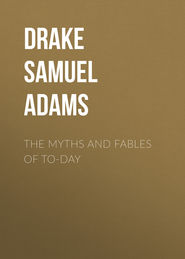По всем вопросам обращайтесь на: info@litportal.ru
(©) 2003-2024.
✖
The Taking of Louisburg 1745
Настройки чтения
Размер шрифта
Высота строк
Поля
Nor would these discussions be any the less likely to arise, or to grow any the less threatening to the future of crown and colony, when it became known that to balance her accounts with other powers England had handed over Cape Breton to France again, thus putting in her hand the very weapon that New England had just wrested from her, as the pledge to her own security. The work was all undone with a stroke of the pen. The colonies were still to be the football of European politics.
Nobody in the colonies supposed this would be the reward of their sacrifices – that they should be deliberately sold by the home government, or that France, after being once disarmed, would be quietly told to go on strengthening her American Gibraltar as much as she liked. Yet this was what really happened, notwithstanding the Duke of Newcastle’s bombastic declaration that “if France was master of Portsmouth, he would hang the man who should give up Cape Breton in exchange for it.”
King George, who was in Hanover when he heard of the capture of Louisburg, sent word to Pepperell that he would be made a baronet, thus distinguishing him as the proper chief of the expedition. This distinction, which really made Pepperell the first colonist of his time, was nobly won and worthily worn. After four years of importunity the colonies succeeded in getting their actual expenses reimbursed to them, which was certainly no more than their dues, considering that they had been fighting the battles of the mother country.[27 - The amount was £183,649 to Massachusetts, £16,355 to New Hampshire, £28,863 to Connecticut, and £6,332 to Rhode Island. Quite a large portion was paid in copper coins.]
Warren was made an admiral. The navy came in for a large amount of prize money, obtained from ships that were decoyed into Louisburg after it fell, to the exclusion of the army.[28 - Among others the navy took a Spanish Indiaman, having $2,000,000, besides gold and silver ingots to a large value, stowed under her cargo of cocoa. The estimated value of all the prizes was nearly a million sterling, of which enormous sum only one colonial vessel got a share.] This disposition of the spoils was highly resented by the army, who very justly alleged that, while the success of the army without the fleet might be open to debate, there could be no question whatever of the fleet’s inability to take Louisburg without the army.
THE END
notes
1
Louisburg had cost the enormous sum of 30,000,000 livres or £1,200,000 sterling.
2
Pepperell was besieging Louisburg at the same time the French were Tournay.
3
Canso was taken by Duvivier, May 13, 1744. The captors burnt everything, carrying the captives to Louisburg, where they remained till autumn, when they were sent to Boston. These prisoners were able to give very important information concerning the fortress, its garrison, and its means of defence.
4
Suggestions looking to a conquest of Cape Breton were made by Lieutenant-Governor Clarke of New York, some time in the year 1743 (“Documentary History of New York,” I., p. 469). He suggests taking Cape Breton as a first step toward the reduction of all Canada. Then, Judge Auchmuty of the Vice-Admiralty Court of Massachusetts printed in April, 1744, an ably written pamphlet discussing the best mode of taking Louisburg.
5
The Revolt occurred in December, over a reduction of pay. The soldiers deposed their officers, elected others in their places, seized the barracks, and put sentinels over the magazines. They were so far pacified, however, as to have returned to their duty before the English expedition arrived. Under date of June 18, one day after the surrender, Governor-General Beauharnois advises the Count de Maurepas of this revolt. He urges an entire change of the garrison.
6
Vaughan was a mill-owner, and carried on fishing also at Damariscotta, Me. He knew Louisburg well. Conceiving himself slighted by those in authority at Louisburg, he went from thence directly to England, in order to prefer his claim for compensation as the originator of the scheme. He died of smallpox at Bagshot, November, 1747. He insisted that fifteen hundred men, assisted by some vessels, could take Louisburg by scaling the walls. “A man of rash, impulsive nature.” —Belknap. “A whimsical, wild projector.” —Douglass.
7
News that an armament was preparing at Boston was carried to Quebec, by the Indians, without, however, awakening the governor’s suspicions of its true object.
8
Gibson was very active during the siege, especially when anything of a dangerous nature was to be done. He was a retired British officer. He was one of the three who escaped death, while on a scout, May 10. With five men he towed a fireship against the West Gate, under the enemy’s fire, on the night of May 24. It burnt three vessels, part of the King’s Gate, and part of a stone house in the city. Being done in the dead of night, it caused great consternation among the besieged.
9
Pepperell’s own regiment was actually commanded by his lieutenant-colonel, John Bradstreet, who was afterwards appointed lieutenant-governor of Newfoundland, but on the breaking out of the next war with France, he served with distinction on the New-York frontier, rising through successive grades to that of major-general in the British army. Bradstreet died at New York in 1774.
10
General Roger Wolcott had been in the Canada campaign of 1711 without seeing any service. He was sixty-six when appointed over the Connecticut contingent under Pepperell. Wolcott was one of the foremost men of his colony, being repeatedly honored with the highest posts, those of chief judge and governor included. David Wooster was a captain in Wolcott’s regiment.
11
Samuel Waldo was a Boston merchant, who had acquired a chief interest in the Muscongus, later known from him as the Waldo Patent, in Maine, to the improvement of which he gave the best years of his life. Like Pepperell, he was a wealthy land-owner. They were close friends, Waldo’s daughter being betrothed to Pepperell’s son later. His patent finally passed to General Knox, who married Waldo’s grand-daughter.
12
Joseph Dwight was born at Dedham, Mass., in 1703. He served in the Second French War also. Pepperell commends his services, as chief of artillery, very highly.
13
Jeremiah Moulton was fifty-seven when he joined the expedition. He had seen more actual fighting than any other officer in it. Taken prisoner by the Indians at the sacking of York, when four years old, he became a terror to them in his manhood. With Harmon he destroyed Norridgewock in 1724.
14
Robert Hale, colonel of the Essex County regiment, had been a schoolmaster, a doctor, and a justice of the peace. He was forty-two. His major, Moses Titcomb, afterwards served under Sir William Johnson, and was killed at the battle of Lake George.
15
Sylvester Richmond, of Dighton, Mass., was born in 1698; colonel of the Bristol County regiment. He was high sheriff of the county for many years after his return from Louisburg. Died in 1783, in his eighty-fourth year. Lieutenant-Colonel Ebenezer Pitts of Dighton, and Major Joseph Hodges of Norton, of Richmond’s regiment, were both killed during the campaign.
16
Samuel Moore’s New Hampshire regiment was drafted into the Vigilant. His lieutenant-colonel, Meserve, afterward served under Abercromby, and again in the second siege of Louisburg under Amherst, dying there of small-pox. Matthew Thornton, signer of the Declaration, was surgeon of Moore’s regiment.
17
Edward Tyng, merchant of Boston, son of that Colonel Edward who was carried a prisoner to France, with John Nelson, by Frontenac’s order, and died there in a dungeon.
18
Major Seth Pomeroy of Northampton, Mass., was lieutenant-colonel of Williams’s regiment in the battle of Lake George, 1755, succeeding to the command after Williams’s death. At the beginning of the Revolution he fought as a volunteer at Bunker Hill.
19
Reference should be made to the plan at page 91 (#Page_91). It will greatly simplify the siege operations to the reader if he will keep in mind the fact that the land attack was wholly confined within the points designated by A and B on this plan, or between the Dauphin and King’s bastions. For our purpose, it is only necessary to add that the harbor front was defended by a strong wall of masonry, joining the Water Battery, G, with the Dauphin Bastion, A. In this wall were five gates, leading to the water-side. It was the point at which the city would be exposed to assault from shipping or their boats.
20
The Island Battery could not materially hinder the progress of the siege, and must have fallen with the city. The Circular Battery could not fire upon the besiegers at all, as it bore upon the harbor, but Warren insisted that he could not go in until these two works were silenced. If the time spent in doing this had been wholly employed in battering down the West Gate and its approaches, the city might have been taken without the fleet, leaving out of view, of course, the supposition of a repulse to the storming party. It is a strong assertion to say that the city could not have been taken without the fleet, because no trial was made.
21
The Attack upon Annapolis having failed, these troops tried to get back to Louisburg, but were unable to do so. With their assistance Duchambon thinks he could have held out.
22
General John Nixon is one of those referred to.











